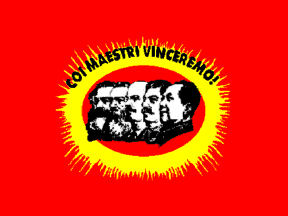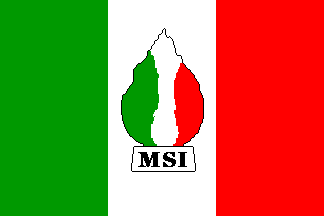.gif)
by Marcus Schmöger, 20 July 2002

Last modified: 2003-04-19 by dov gutterman
Keywords: italy |
Links: FOTW homepage |
search |
disclaimer and copyright |
write us |
mirrors
See also:
.gif)
by Marcus Schmöger, 20 July 2002
For the SDI (Socialisti Democratici Italiani = Italian
Democratic Socialists) I only have found the logo, but no flag.
Marcus Schmöger, 20 July 2002
SDI ("Socialisti Democratici Italiani" = Italian
Democratic Socialists <www.socialisti.org>)
- The SDI is the more left-wing fraction of the former PSI
(Partito Socialista Italiano); for the more right-wing part refer
to the NPSI. Under the leadership of Enrico Boselli it formed
part of the Ulivo coalition in 1996 (in a subcoalition together
with "Rinnovamento Italiano") and 2001 (in the
"Girasole" subcoalition together with the Verdi). The
nine deputies in the Camera dei Deputati and the six senators are
part of the respective mixed group ("Misto"). The logo
shows the symbol of the SPE (Socialist Party of Europe), the rose
with twelve stars in a circle, as the main symbol (see also logo
and flag of the "Democratici di Sinistra"). I have not
found any evidence for a flag of the SDI, but presumably they
have one, as most Italian parties, especially those with
socialist roots, have flags.
FGS ("Federazione Giovani Socialisti"= Federation Young
Socialists <www.giovanisocialisti.it>)
is the youth organization of the SDI, that has its own symbols.
The logo can be found at <www.giovanisocialisti.it/simbolo.jpg>.
The multi-coloured rose of the logo is also the main feature of
the flag of the FGS. However, there are also several
inscriptions, not all of which I could figure out on the (not
very clear and sharp) fotos.
Fotos of the flag can be found at <www.giovanisocialisti.it/Image038.jpg>,
<Image040.jpg>,
<Image077.jpg>,
<malmoestand.jpg>,
<malmoedaily2.jpg>,
<malmoedaily3.jpg>,
<malmoedaily4.jpg>,
<malmoedaily5.jpg>,
<genova2000_1.jpg>,
<genova2000_2.jpg>,
<craxi_1.jpg>,
<craxi_2.jpg>
and <gbrunored_small.jpg>.
Marcus Schmöger, 31 July 2002
.gif)
by Marcus Schmöger, 7 August 2002
PLI ("Partito Liberale Italiano" = Italian Liberal
Party <www.partitoliberale.it>)
- Founded back in 1922, the PLI was one of the smaller parties in
the old party system until 1992. However, this basically
right-liberal party (the left-liberal ideas could be found in the
PRI and the "Partito Radicale") took part in most of
the DC-led governments of that era. After 1992 the party, struck
by many scandals, almost disappeared, especially as many of the
prominent members either directly became member of the
"Forza Italia" or founded small parties supporting the
FI in the center-right coalitions (for instance the "Unione
di Centro" led by Costa and Biondi). The current logo shows
(on a white field) a big black letter "L" with a waving
tricolore, beneath the inscription "Partito Liberale".
Marcus Schmöger, 7 August 2002
Previous Flag

by Marcus Schmöger, 7 August 2002
At least in former times the PLI had a flag, namely the
Italian tricolore with the black letters "PLI" on it.
This is shown in [smi75g], p.
340.
Marcus Schmöger, 7 August 2002

by Marcus Schmöger, 8 August 2002

by Marcus Schmöger, 8 August 2002
PMLI ("Partito Marxista-Leninista Italiano" =Italian
Marxist-Leninist Party <www.pmli.it>)
- This is a small maoist party, founded in 1977, but having as
predecessor the OCBI-ML (Organizzazione Comunista Bolscevica
Italiana Marxista-Leninista), founded in 1969. The main flag is
described in the statute (Art. 33), see <www.pmli.it/statutopmli.html>:
"La bandiera del Partito è rossa, con falce e martello neri
al centro e l'effige di Mao Zedong in nero posta in alto dalla
parte dell'asta." (The flag of the party is red, with black
hammer & sickle in the center and the image of Mao Zedong in
black in the upper hoist.)
As the PMLI adheres to the teachings of Marx, Engels, Lenin,
Stalin and Mao, whom they consider "maestri" (masters),
the also use a red flag with the images of these five (in black),
surrounded by a yellow sun-like border and the inscription
"Coi maestri vinceremo" (With the masters we shall
conquer).
Drawings and fotos of the flags at <www.pmli.it/images/Bandieramaestri02.gif>,
<www.pmli.it/22032002.htm>
and <16042002.htm>.
Marcus Schmöger, 8 August 2002
A centrist party
G. Vacca, 22 September 1997
.gif)
by Marcus Schmöger, 19 July 2002
One of the variants of the logo of the PPI (belonging to
"Margherita", sub-coalition of Ulivo). Although the PPI
has flags, I have not enough information of the flag.
Marcus Schmöger, 19 July 2002
PPI ("Partito Populare Italiano" = Italian People's
Party <www.popolari.it>)
- The PPI is the biggest of the parties with roots in the old
"Democrazia Cristiana" (DC), taking its name from the
pre-WW2 PPI of Don Luigi Sturzo. As the DC, after many scandals,
renamed itself into PPI 23 January 1994 , the right fraction left
the party to found the CDU (). After the defeat in the 1994
elections, where the PPI formed a centrist coalition with Segni's
"Patto per l'Italia", a discussion commenced if the
party should ally itself with the center-right coalition of
Berlusconi or the center-left coalition. As the majority voted
for the center-left option, on 23 July 1995, another fission
occurred the right fraction (including the former PPI leader
Rocco Buttiglione) founded the CDU (). Now the PPI (under the
leadership of Pierluigi Castagnetti) represents mainly the
left-catholic wing of the old DC and accordingly allied itself
with other center-left parties in the L'Ulivo coalition (for the
1996 and 2001 elections). In the two parliamentary chambers the
PPI members are part of the "Margherita" group.
The logo of the PPI shows on a blue field a white gonfalone with
an escutcheon with outline in red and a red cross, across the
escutcheon the inscription "POPOLARI"; around the logo
the inscription "PARTITO POPOLARE ITALIANO". The
escutcheon with the red cross recalls the old symbol of the
"Democrazia Cristiana" (that had the inscription
LIBERTAS on the cross) and can be found in a similar form in
other parties claiming heritage of the DC (CDU, CCD, DE). The
flag is white and shows the logo in the center. However, as I
only found one foto, where the flags were not clearly visible due
to being waved. Foto of the flag at <www.popolari.it/FotoMassaCarrara.jpg>.
Marcus Schmöger, 1 August 2002

by Marcus Schmöger, 15 July 2002
Logo of "Rinnovamento Italiano". It belongs to the
left-center The Olive Tree
(L'Ulivo) coalition (currently in opposition). All these parties
belong to the sub-coalition "Margherita".
Marcus Schmöger, 15 July 2002
"Rinnovamento Italiano" (Italian Renewal, a.k.a.
Lista Dini <www.rinnovamento.it>)
- "Rinnovamento Italiano" is one of the "one-man
band" parties emerging in Italy in the 1990ies. Its founder
(and also leader up to now) Lamberto Dini was prime minister of a
technocratic government 1994-1996, and founded the party
(originally called "Lista Dini") for the 1996
elections. It took part in the "L'Ulivo" coalition in
1996 (in a sub-coalition with the SDI) and 2001 (in the
"Margherita" sub-coalition). In the two parliamentary
chambers the "Rinnovamento" members are part of the
"Margherita" group.
The logo of "Rinnovamento Italiano" shows on a blue
field a triangle in the national colors, above that the
inscription "LISTA DEL RINNOVAMENTO ITALIANO", around
the logo 15 yellow stars. I have sent a gif of the logo on 15
July. I don't know if the "Rinnovamento Italiano" has a
flag.
Marcus Schmöger, 1 August 2002
.gif)
by Marcus Schmöger, 7 August 2002
PRI ("Partito Repubblicano Italiano" = Italian
Republican Party <www.pri.it>)
- Founded back in 1895, the PRI is the second-oldest party in
Italy. It is a laical, left-liberal party, that has, however,
taken part in most of the DC-led governments until 1992. In
1981-1983 Giovanni Spadolini, the leader of the party, even
became Italian prime minister of a five-party coalition.
Different from other parties of the old system, it was not struck
so much by the scandals around 1992. However, there occurred
several fissions, the products of which usually allied themselves
with the center-left coalition. As being closer to the left, the
remaining PRI itself allied in 1996 with the left-center
coalition "L'Ulivo" of Romano Prodi. Not much, however,
has been heard of the PRI recently. For quite some time the main
symbol of the PRI has been the ivy leaf. The current logo shows
the ivy leaf on a white background, surrounded by the name of the
party in green letters. Logo at <cedweb.mininterno.it:8890>.
Being one of the oldest Italian parties, there are some fotos of
historical banners of local PRI branches on the web. These
feature (on a red or black field) inscriptions, portraits, a sun,
but also always ivy twigs. See <consiglio.regione.emilia-romagna.it>.
Marcus Schmöger, 7 August 2002
See: Italian Socialist Party - Historical Flags

by Antonio Martins, 9 January 2000
Movimento Sociale Italiano, Mussolini nostalgists; I'm not
sure if this party is still active : Tricolor flame burning from
a basis with "MSI" lettering on the central panel of
the national flag. Based on Paal Ekran's anti-nazi website <www.ekran.no>.
Almost identical design as France's Front National
Antonio Martins, 9 January 2000
If I am correct, the MSI was relooked to form G. Fini's "Allianza Nazionale"
(claiming to be non-fascist and modern) after the death of his
historical leader, a former minister of the Duce .I seem to
remember that A.N. still uses the flame in his logo.
Ivan Sache, 10 January 2000
the referred "historical leader" was (as far as I
know) Giorgio Almirante. I had no idea of his being a minister in
the Fascist government, however.
Santiago Dotor , 11 January 2000
Almirante (1914-1988) started his carreer in 1932 as
journalist in the antisemit newspaper "Tevere". He was
appointed Chief of Cabinet of the Minister of Culture in 1944
(during the Italian Social Republic).
He founded the MSI, clearly inspired by the fascist ideology, in
1944 and ruled it until 1950. He was then replaced by Michelini
who tried to move the party towards the Christian Democracy and
the Monarchists. Almirante then ruled the most radical wing of
the party and was involved in violent actions such as the assault
of the University of Roma in 1968. When Michelini died in 1969,
Almirante was called back as secretary of the MSI. He tried to
present himself as the protector of order and freedom against
communism and extreme-right. The fascist symbols were removed in
1970. In 1973, the MSI merged with parts of the Monarchists and
changes his name to MSI - National Right. In the same time,
Almirante motivated by his verbal aggressivity small terrorist
groups like Ordine Nuovo, Avanguardia Nazionale, Squadre d'Azione
Mussolini, but his direct responsability in terrorist actions was
never proved. Ordine Nuovo and his leader P. Rauti rallied the
MSI - NR in 1969, but the moderates left in 1976. In the Congress
of Sorrente (December 1987), Almirante resigned but won against
Rauti, and G. Fini was elected.
Source: Obituary in Encyclopaedia Universalis
(Universalia 1989).
Therefore, as I said in my previous message, Fini's Allianze
Nazionale was built over the rests of the MSI.
Ivan Sache, 11 January 2000
I worked during two years as international secretary in a
french political structure. Even if this structure was not linked
with the italian MSI, here is some information:
Antonio Martins was right when he says that Italian-MSI flame was
similar to the French-FN one. Some frenchs books about the
extreme-right party explained that G.Almirante gave to Jean-Marie
Le Pen, MEP and founder of the FN, a sort of copyright to use its
tricolour flame in blue-white-red, when Le Pen created the
FN, in 1972.
Jerome Sterkers, 14 November 2001
Then the relationships between both parties, or rather between
both leaders, turned sour. MSI refused to admit FN in its
supra-national group in European Parliament, and I seem to
remember that Almirante explicitely forbid Le Pen to take part to
his funerals.
Ivan Sache, 14 November 2001
The MSI has renamed itself into AN (National
Alliance - Alleanza Nazionale).
Marcus Schmöger, 1 August 2002